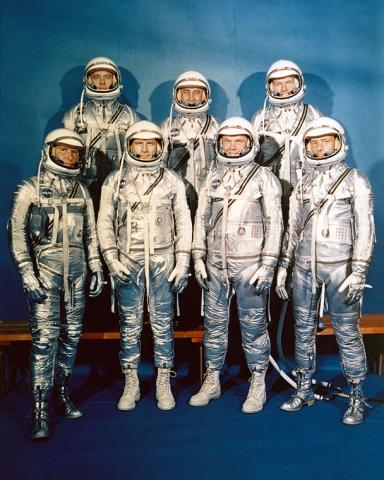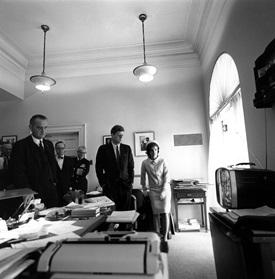"I believe that this nation should commit itself to achieving the goal, before this decade is out, of landing a man on the Moon and returning him safely to earth.” - President John F. Kennedy, May 25, 1961
About the Exhibit
The U.S. space program went full throttle in 1961 when President John F. Kennedy challenged the nation to claim a leadership role in space and land a man on the Moon before the end of the decade. On display in this exhibit are documents and photographs chronicling the key events in the nation's space program during the Kennedy Administration. A video presentation features archival footage of Astronauts Alan Shepard and John Glenn's respective space missions and excerpts from President Kennedy's September 12, 1962 speech at Rice University in Houston, Texas where he restated the nation's resolve of landing a man on the moon and returning him safely to the earth before the end of the decade.
Mercury Freedom 7
Project Mercury was NASA’s first manned space flight program, undertaken in 1958. In one of its six manned missions, on May 5, 1961, U.S. Navy Commander Alan B. Shepard, Jr., soared into history. Crammed into this Mercury Space Capsule that he named Freedom 7, Shepard, a native of East Derry, New Hampshire, became the first American to travel in space. Clamped atop a Redstone rocket nearly 7 stories high, the capsule was blasted into sub-orbital flight that laid to rest any doubts that man could function in space—at least for a short period. In a mission that lasted just over 15 minutes, Alan Shepard managed and monitored 27 events and communicated with Mercury Control 78 times.
Freedom 7’s mission was a milestone along the course charted by President Kennedy to make the United States number one in the world in space exploration. Three weeks after this capsule safely splashed down in the Atlantic Ocean, President Kennedy announced to the nation the goal of landing a man on the moon and returning him safely to earth before the end of the decade.
Mercury Friendship 7
On February 20, 1962, Marine Corps Lieutenant Colonel John H. Glenn, Jr. piloted the Friendship 7 spacecraft on the first American manned orbital mission. John Glenn blasted into orbit as part of a space race between the United States and the Soviet Union in which the Americans were lagging. He completed three orbits around the earth. The mission duration from launch to impact was 4 hours, 55 minutes, and 23 seconds. As President Kennedy had hoped, the successful space flight did much to restore American prestige worldwide.
President Kennedy made clear his administration's priority for the United States to land a man on the moon before the Soviet Union in a White House meeting that took place on November 21, 1962. America responded with one of the greatest mobilizations of resources and manpower in U.S. history. He later stated "We choose to go to the moon! We choose to go to the moon in this decade and do the other things, not because they are easy, but because they are hard." This goal was achieved on July 20, 1969, when two American astronauts walked on the Moon. It was a stunning achievement that boosted American confidence and prestige at home and around the world.


